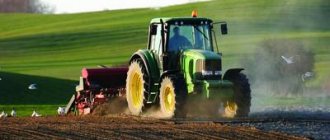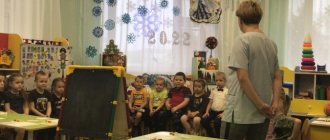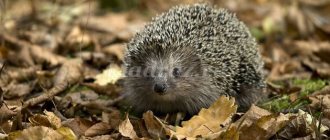Summary of GCD for modeling using waste material in the middle group "Car"
Publications on the topic:
"Maple Leaf". Applique from paper and fabric using waste material Applique is one of the types of visual arts based on cutting out, overlaying various shapes and fixing them on another.
Summary of a lesson on sculpting using natural materials in the junior group “Walnut Mouse” Summary of a lesson on sculpting using natural materials in the junior group on the topic “Walnut Mouse”
Purpose: To fail.
Photo report on GCD for sculpting using natural material “Spiders on a cobweb” Photo report on GCD for sculpting using natural material “Spiders on a cobweb”. Goal: to develop the ability to sculpt a spider, conveying its characteristics.
Summary of GCD for sculpting using natural material “Chamomile” (second junior group) Summary of GCD for non-traditional modeling techniques Age: Second junior group Topic: “Chamomile” with pumpkin seeds Program objectives: Educational:.
Summary of a lesson on designing in the middle group, from waste material (candy wrappers) “The Cheerful Clown” Purpose: - to introduce children to circus performers, to the profession of a clown - to teach children to work with waste material (candy wrappers), - to teach.
"Cockerel." Master class made from paper using waste material from candy wrappers. A cheerful and magical New Year holiday is coming. Each of us has a lot of sweets at home, and therefore candy wrappers, I suggest you make them.
Master class “Children making crafts “Birdhouse on a tree” using waste material” MASTER CLASS CHILDREN MAKING CRAFTS “BOOKBOOK ON TREE” senior preschool age CRAFT “BOOKBOOK ON TREE” USING.
GCD plan for modeling “Mushrooms grow in our forest.” Collective composition using natural materials Goal: to consolidate ideas about mushrooms that grow in our forest, to show techniques for conveying their images in sculpting. Objectives: exercise.
Lesson in the middle group on modeling using natural material “Aquarium” (team work) Topic: “Our aquarium”. Goals: To intensify the use of various sculpting techniques to create beautiful aquatic plants and decorative fish; continue.
A lesson in modeling using natural materials in the middle group. Collective work “Aquarium” Class in a secondary group on modeling using natural material “Aquarium” (team work) Tatyana Zvyagina Class in a secondary group.
Notes Nod in the middle group modeling on the topic "Transport"
Summary of GCD in the middle group
Modeling
Topic: Transport
Objectives of the lesson.
Cognition:
deepen and expand knowledge about ground transport. Learn to identify similar and different characteristics of passenger cars - size, color, shape; and car parts - trunk, hood, interior, wheels, steering wheel, etc. Give an idea of car models.
Communication:
development of coherent speech. Activation, expansion of the dictionary.
Artistic creativity:
develop the ability to paint over an image with plasticine – “Plasticineography”.
Material:
models of cars of various brands (or pictures of cars, see Appendix). A5 cardboard with a picture of a passenger car for painting (see appendix).
GCD move.
A car horn sounds. The teacher attracts the children and leads them to the cars on display.
Educator:
Today a car exhibition has come to visit you. Look carefully at the cars and tell me what this type of transport is called?
Children:
Ground, passenger.
Educator:
Right. How do you think these cars are similar?
Children
: All cars have wheels, headlights, hood, doors, interior, steering wheel, seats, trunk.
Educator
: Right. Now, guys, look and tell me, how are these cars different?
Children:
All cars are different colors. Different shapes of trunk, headlights. Some cars have different numbers of doors.
Educator:
Right. Why do you think they are so different?
(children's assumptions)
Educator:
Each plant produces different models of cars. Some people like black cars, some like red ones. If the family is large, then the number of seats in the car is needed. But some driver needs to transport cargo, for example, to the country, and he will choose a car with a large trunk. That’s why they produce different models of cars – for the convenience of people.
Educator:
So who can tell me why the cars are different and why they do it? (The teacher listens to the answers of several children and praises them.)
Gymnastics for the eyes “Follow the movement of the car” is carried out.
Physical education lesson “ We’re going, we’re going home.”
We're going, we're going home (movements simulating turning the steering wheel)
By car
We drove up the hill: bang. (Hands up, clap overhead)
The tire goes flat: stop. (Arms downwards, squat)
At the tables.
Educator:
Now I will give you images of a passenger car, but it is not painted and you will need to color it. And we will paint with plasticine. Who remembers how this is done? (Children's answers).
We remind the teacher how to work with plasticine: pinch off a piece and distribute it over the image. We don't go beyond the lines.
Educator:
Guys, we found out that cars come in different colors, depending on who you like. Therefore, you choose the color of the car yourself. What won't we paint over? (Window). Well done, get to work.
At the end of the activity, a work analysis is carried out. If the children do not have time to finish the work, it can be continued in the evening.
Project for children of the preparatory group “All types of transport are important, All types of transport are needed!”
Educational activities in non-GCD:
Conversation . ”
Goal: To introduce children to the history of transport. Develop children's cognitive activity by enriching their understanding of transport.
Conversation: “What types of transport are there?”
Goal: Expand children's understanding of types of transport. Learn to make simple generalizations. Develop self-control and the ability to listen to other children.
Conversation: “Why does a person need a car?”
Goal: To improve children's knowledge about the need for machines in human life.
Conversation: “All professions are important”
Goal: Expand ideas about transport-related professions.
Situational conversation with children on the topic:
“ The street is full of surprises .”
Goal: To develop basic knowledge about the rules of behavior on the road, to develop the ability to adequately respond to road situations. Encourage children to participate in solving problem situations.
Didactic games and educational games:
«I'll start and you finish»
Goal: To develop knowledge about types of transport. Develop memory, attention, articular apparatus.
"Who controls what?»
Goal: Improve grammatical structure, practice the ability to use nouns in the instrumental case; expand children's knowledge about the professions of people working in transport.
“ Choose the word”, “One is many”, “The fourth is odd”, “Say the opposite” Goal.
Exercise children in selecting adjectives. Consolidate acquired knowledge. Develop imagination, logical thinking, memory, dialogical speech.
“Pick a sign”:
car (which one?), plane (which one?), etc.
Goal: To develop the ability to coordinate adjectives with nouns.
Hatching in “Transport” notebooks
Goal: To exercise the ability to hatch only in a given direction, not to go beyond the contours of the figure
Graphic dictation "Boat".
Goal: To develop the ability to navigate on a sheet of paper and listen carefully to an adult.
Creative task “The bus stopped because...”.
Goal: to consolidate the ability to compose detailed sentences.
Game "On the Highway".
Goal: To create conditions for the automation of hissing sounds in speech.
Role-playing game "Bus"
Goal: To develop children’s knowledge about the work of a driver and conductor. Learn to independently come up with a game plot and develop it, remember the rules of behavior for passengers on public transport, and communication etiquette.
Role-playing game. "Drivers"
Goal: To encourage children to more widely use knowledge about the life around them in games.
Role-playing game. "Ship Trip" Purpose:
Encourage children to use environmental knowledge more widely and creatively in games: expand children’s understanding of the work of adults - river transport workers. To develop in children the ability to jointly develop a game, coordinating their own game plan with the plan of their peers. Continue to teach children to perform various roles in accordance with the plot of the game, using attributes and building materials.



